
Non Contingent Reinforcement in Autism
Transforming Autism Interventions with Non-Contingent Reinforcement
Understanding Non Contingent Reinforcement (NCR) in Autism Therapy
Non Contingent Reinforcement (NCR) has emerged as a pivotal strategy in behavioral interventions for autism. Its core principle involves the delivery of stimuli that serve as reinforcers to the individual, independent of their current behaviors. This approach seeks to systematically modify the environment to reduce problematic behaviors such as self-injury, aggression, and destructiveness, while simultaneously promoting adaptive and appropriate behaviors. NCR’s simplicity, along with its empirical support, makes it a valuable tool in both clinical and everyday settings, providing a foundation upon which more complex interventions can be built.
What is Non Contingent Reinforcement (NCR) in Autism Treatment?
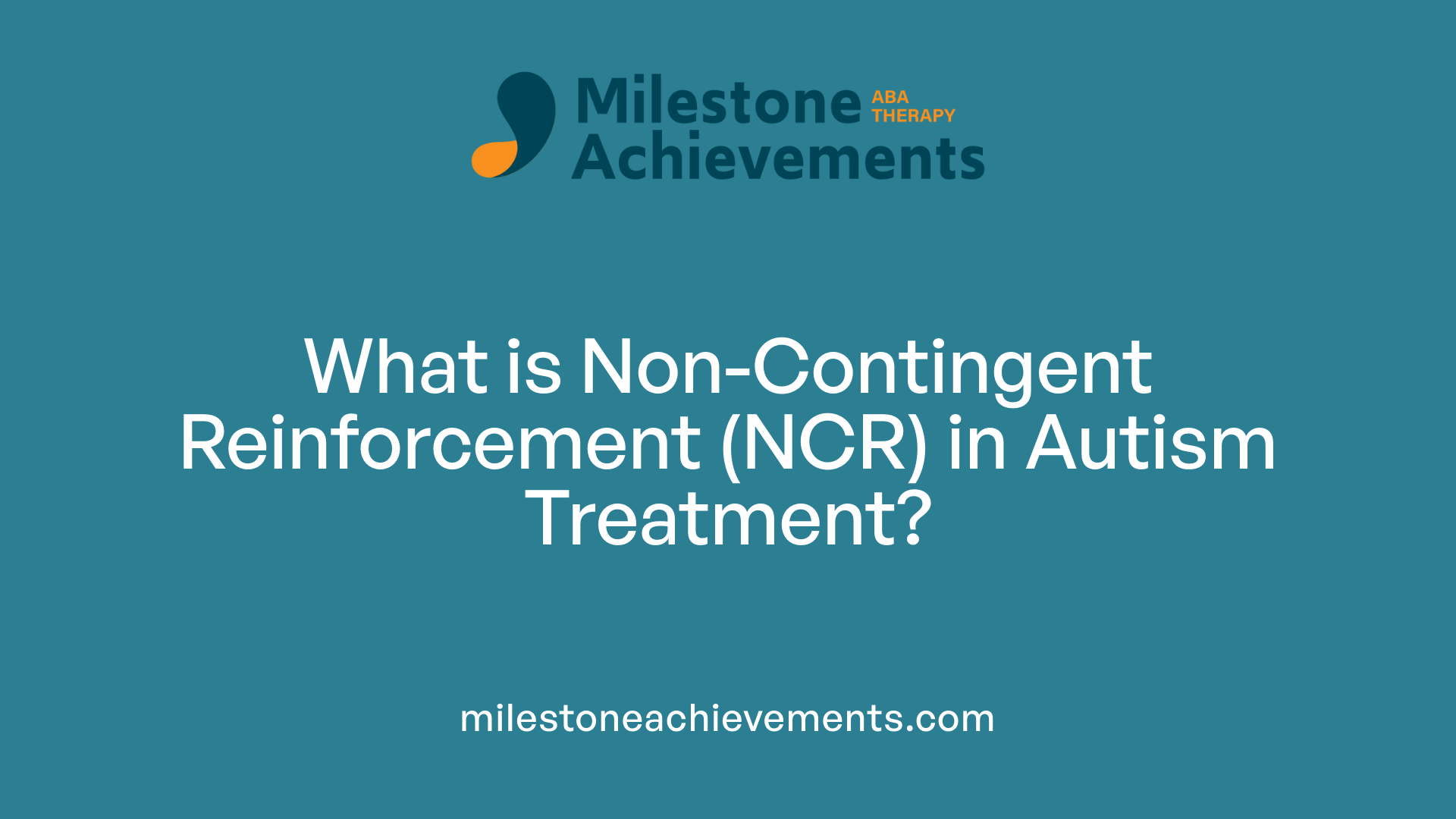
What is non-contingent reinforcement (NCR) in autism treatment?
Non-contingent reinforcement (NCR) is a behavioral strategy used in autism treatment that involves delivering reinforcement without tying it directly to a specific behavior. This means providing preferred items, attention, or activities on a set schedule, regardless of what the individual is doing at the moment.
The main goal of NCR is to reduce problematic behaviors such as self-injury, aggression, and destructive actions. By offering reinforcement independently of the individual's behavior, NCR can decrease the motivation to engage in these behaviors, especially if they serve to access desirable stimuli.
This approach also encourages more appropriate behaviors, like increasing on-task activity or compliance with instructions. It is relatively simple to implement, making it accessible for staff who may not have extensive training in behavioral intervention.
Furthermore, NCR can help lessen the occurrence of extinction bursts—temporary increases in problematic behavior that sometimes happen when reinforcement for certain behaviors is suddenly removed. As an initial intervention, NCR can create a supportive environment while more targeted strategies are developed.
In summary, NCR systematically provides positive experiences and rewards to promote an environment that discourages harmful behaviors and fosters positive engagement, supporting overall developmental progress in individuals with autism.
Differentiating NCR from Other Reinforcement Strategies
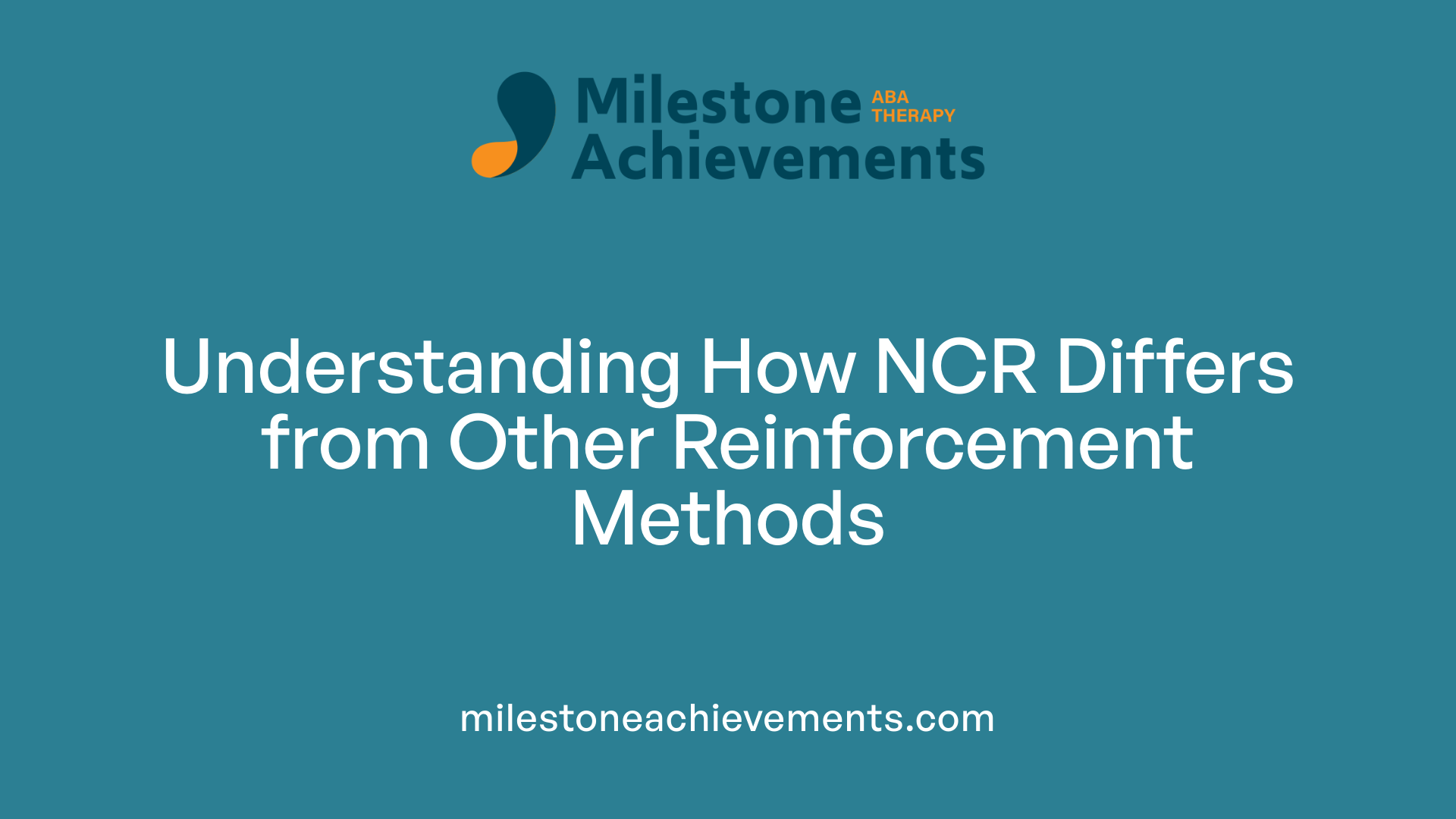
How does non-contingent reinforcement differ from contingent reinforcement?
Non-contingent reinforcement (NCR) and contingent reinforcement are both strategies used in applied behavior analysis (ABA) to influence behavior, but they function quite differently.
NCR involves providing reinforcers on a set schedule that is independent of the individual's current behavior. This means that the individual receives certain stimuli—such as attention, sensory input, or preferred items—regardless of what they are doing at the moment. The main goal of NCR is to reduce problematic behaviors maintained by a constant craving or need for attention, escape, or tangible items by offering these reinforcers unconditionally.
In contrast, contingent reinforcement depends directly on a specific target behavior. When an individual performs the desired behavior, they receive a reward. This response-dependent approach strengthens the likelihood that the behavior will occur again. For example, a child might receive a sticker only after completing a math problem.
The core difference lies in timing and dependency. NCR is response-independent, delivered at regular intervals regardless of behavior, aiming to modify motivation and reduce the motivation for problem behavior. Meanwhile, contingent reinforcement relies on the behavior occurring first, reinforcing only the desired responses to increase their frequency.
NCR's strength is in its ability to create a predictable, consistent environment that can help reset an individual's mood or motivation, often decreasing behaviors such as aggression or self-injury. Meanwhile, contingent reinforcement is effective in teaching new skills and encouraging specific behaviors through immediate rewards.
To summarize, NCR weakens the link between behavior and reinforcement, reducing reliance on responses to obtain stimuli, while contingent reinforcement directly increases specific behaviors by rewarding them. Both methods are valuable tools in ABA, chosen based on the behavior's function, the individual's needs, and the context of intervention.
Techniques and Applications of NCR in Autism
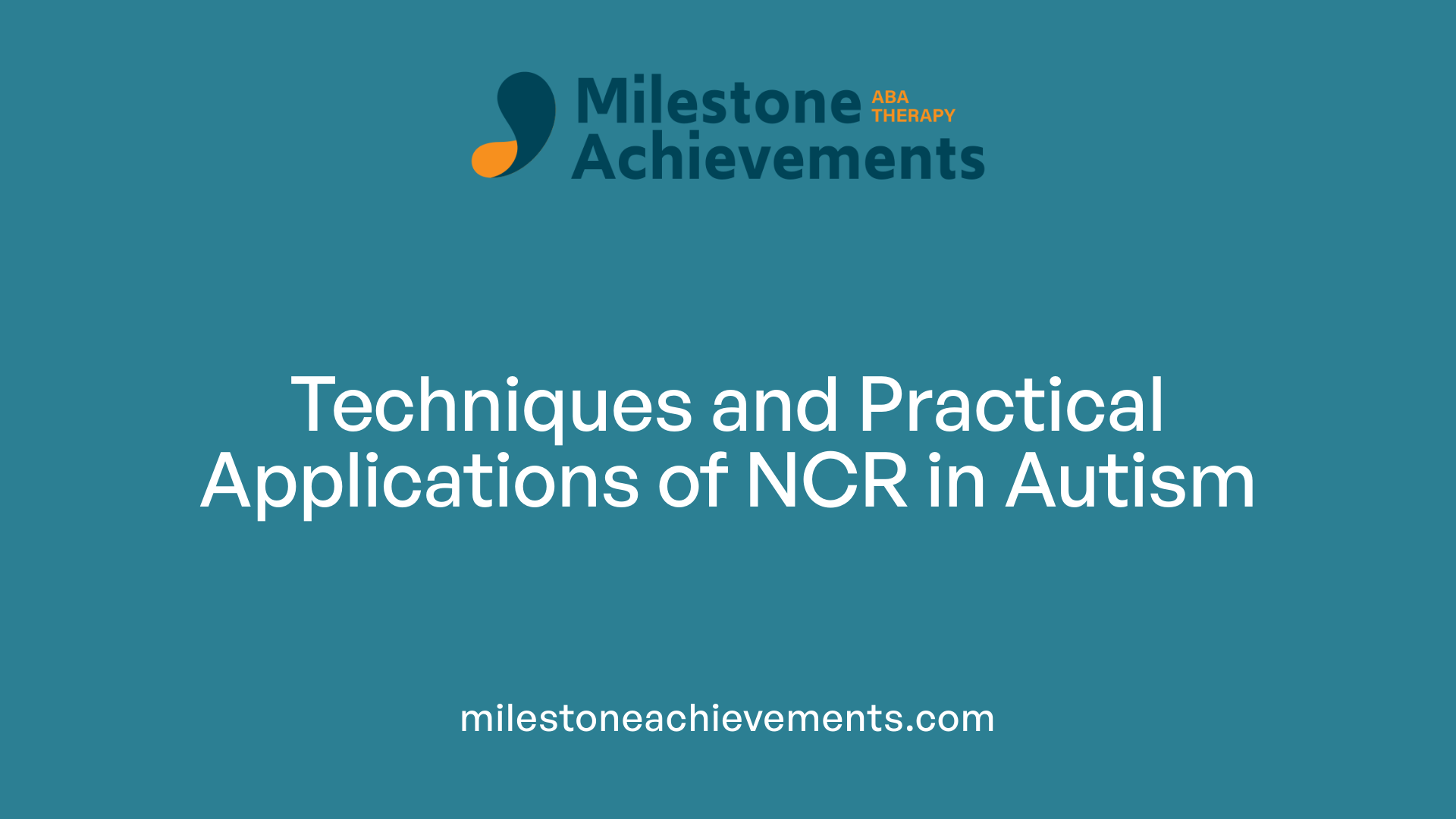
Examples of NCR in practice
Noncontingent reinforcement (NCR) is widely used in autism interventions to manage challenging behaviors and promote positive interactions. One common application involves providing children with autism regular sensory breaks or fun activities scheduled independently of their behavior. For instance, teachers might offer scheduled recess or sensory calming activities at fixed times, regardless of whether the child has demonstrated problematic behaviors. This approach helps create a predictable environment and reduces the motivation to seek attention or other reinforcers through disruptive actions.
In clinical settings, NCR often includes delivering preferred edible items or toys on a set schedule to decrease escape behaviors or problematic seeking actions. For example, an inpatient treatment plan for an 8-year-old girl with autism and other conditions involved systematically giving her access to preferred foods at regular intervals, which effectively increased compliance and decreased aggression or self-injury. Similar strategies can be adapted for various age groups, from preschool to high school, with modifications tailored to individual needs.
Common reinforcers used in NCR
Reinforcers in NCR are typically chosen based on individual preferences and may include edible treats, social attention, sensory stimuli, or preferred activities. For instance, providing praise or social interactions at scheduled times can serve as effective reinforcers to improve mood and compliance.
Preferred items, such as favorite toys or activities, are also commonly used. Sensory stimulation, like calming music or tactile stimuli, can be delivered as part of the NCR schedule to help prevent overstimulation or agitation.
The goal is to select reinforcers that are highly motivating for the individual, supporting positive behavior and reducing the need for disruptive seeking actions. Systematic use of these reinforcers on a fixed or variable schedule helps to stabilize behavior and build a supportive learning environment.
Scheduling of NCR (fixed-time, variable-time)
NCR typically involves arranging reinforcement on a fixed-time (FT) schedule, where reinforcers are delivered at regular, predetermined intervals, or on a variable-time (VT) schedule, where the intervals vary unpredictably but within a certain range. Fixed-time schedules might include giving attention or snacks every 15 minutes, whereas variable-time schedules could involve delivering reinforcement randomly around an average duration.
Both approaches have their benefits. Fixed schedules ensure predictability, helping to establish routines, while variable schedules can maintain engagement and prevent habituation. The choice depends on the individual's needs and the specific behaviors targeted for modification.
Use of NCR as an antecedent intervention
Using NCR as an antecedent intervention involves providing reinforcement before any problematic behavior occurs, aiming to prevent the development of disruptive actions. For instance, a teacher might systematically give attention or preferred activities at set times to reduce the likelihood of disruptive attention-seeking behaviors.
This strategy can be particularly effective for behaviors maintained by escape from demands or attention, as it weakens the reinforcement contingency that sustains these behaviors. Since NCR can be implemented with minimal specialized training, staff can easily incorporate it into daily routines, creating a more positive and predictable environment.
In summary, NCR in autism interventions involves the scheduled, response-independent delivery of preferred stimuli or activities. It is a versatile tool that, when used appropriately, can decrease problem behaviors, enhance compliance, and foster a more engaging learning environment across various settings and age groups.
Empirical Evidence Supporting NCR in Autism Treatment
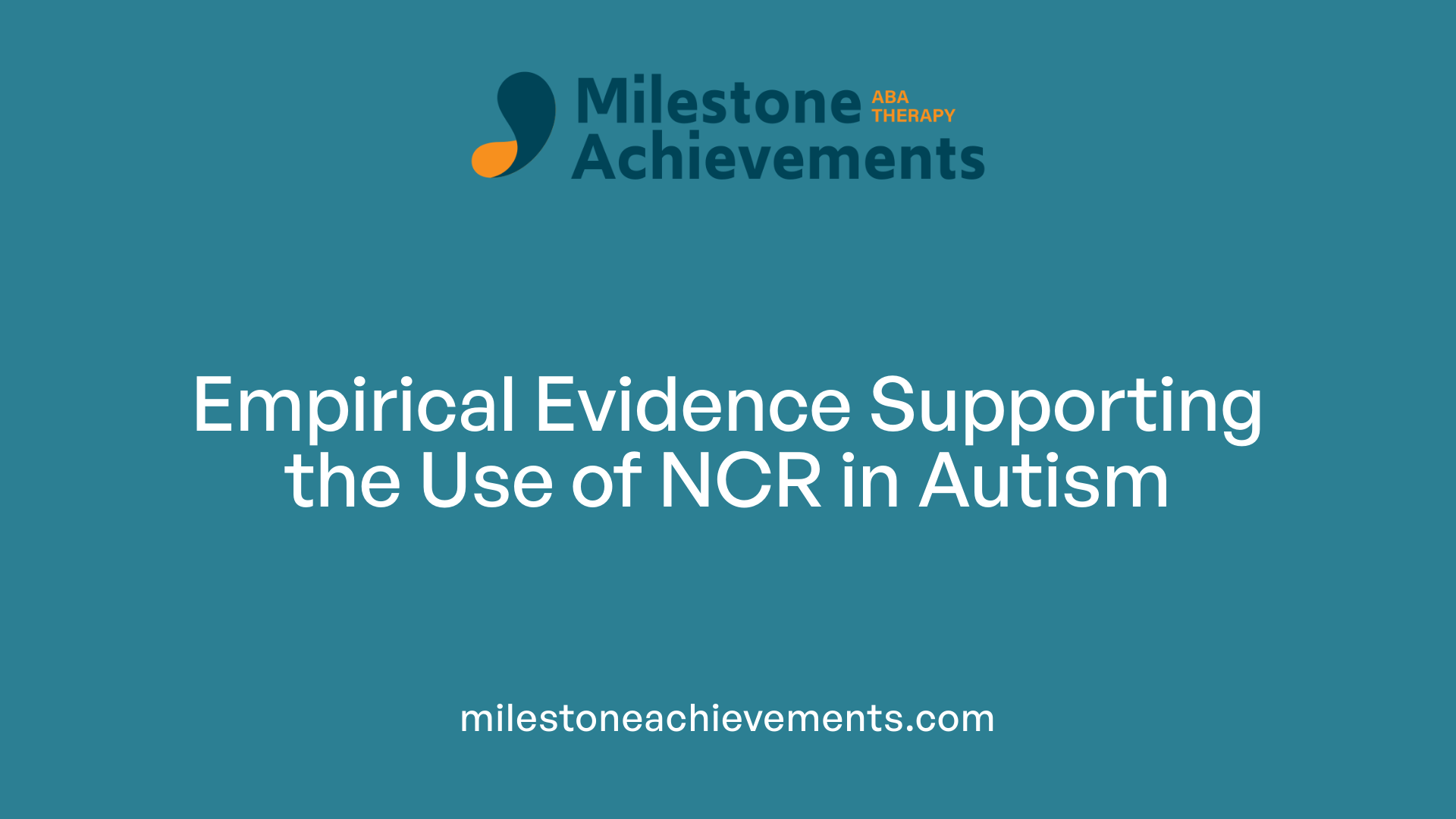 Research studies and findings have established noncontingent reinforcement (NCR) as an effective intervention for managing problem behaviors in individuals with autism. Numerous experimental studies indicate that providing access to preferred items or activities on a set schedule—regardless of the individual's behavior—can significantly reduce behaviors such as aggression, self-injury, and property destruction.
Research studies and findings have established noncontingent reinforcement (NCR) as an effective intervention for managing problem behaviors in individuals with autism. Numerous experimental studies indicate that providing access to preferred items or activities on a set schedule—regardless of the individual's behavior—can significantly reduce behaviors such as aggression, self-injury, and property destruction.
In one noteworthy study involving an 8-year-old girl with autism, mild cerebral palsy, and obsessive-compulsive disorder, NCR delivered edible reinforcers independently of her actions. The results showed a marked decrease in her escape-maintained problem behaviors, coupled with increased compliance. Both low-density and high-density schedules of NCR proved effective, and similar outcomes were observed when compared to differential reinforcement of compliance (DRA).
Case examples highlight that NCR can be applied across various behaviors linked to escaping demands, seeking sensory input, or obtaining tangible items. For instance, scheduled sensory breaks or scheduled social attention can diminish disruptive behaviors and improve the learning environment. These interventions are easy to implement, often by staff with minimal behavioral training, and do not require complex procedures like escape extinction.
Systematic reviews of single-case experimental design studies further support NCR as a well-supported strategy within applied behavior analysis (ABA). The evidence suggests that NCR not only decreases problem behaviors but also fosters increased appropriate behaviors, such as being on-task or engaging in social interactions. The consistency of findings across different settings and age groups underscores its flexibility and robustness.
In sum, research robustly supports NCR as an empirically validated approach for reducing challenging behaviors and promoting positive engagement among individuals with autism, making it a valuable component of behavioral interventions.
Implementing NCR: Best Practices and Considerations

How do I choose the right reinforcers for NCR?
Selecting effective reinforcers is essential for NCR success. The reinforcers should be highly motivating and preferred by the individual, such as favorite edible items, sensory activities, or social praise. In the case of children with autism, for example, preferred edible items used in a recent study effectively increased compliance and reduced problem behavior when delivered noncontingently. Identifying reinforcers through preference assessments can ensure that the reinforcers used are meaningful, improving engagement and reducing problematic behaviors.
What scheduling strategies work best for NCR?
NCR typically involves delivering reinforcement on a fixed-time schedule, meaning the reinforcer is provided at set intervals regardless of behavior. For example, providing sensory breaks or attention every few minutes can help reset mood and reduce the need for escape-maintained behavior. The schedule can be started at a higher frequency to establish the intervention and then gradually thinned over time — spreading reinforcement further apart — to promote generalization and independence. Thinning schedules must be carefully managed to avoid regression while maintaining behavioral gains.
How important is fidelity when implementing NCR?
Maintaining high procedural fidelity is crucial for NCR’s effectiveness. Staff and caregivers need to consistently deliver reinforcement response-independently, regardless of the individual’s behavior. Proper training on NCR procedures, including identifying suitable reinforcers, setting schedules, and reducing attention for problematic behaviors, helps prevent inconsistent application that could undermine treatment outcomes. Systematic monitoring and coaching support sustained fidelity over time.
Can NCR be combined with other strategies?
Yes, NCR often works well when combined with other behavioral interventions. For instance, NCR can be used initially to decrease problem behaviors before implementing more targeted strategies like functional communication training or differential reinforcement of alternative behaviors (DRA). Combining NCR with strategies such as reinforcement fading or extinction can enhance overall treatment effectiveness, especially when addressing complex behaviors.
| Aspect | Description | Example |
|---|---|---|
| Reinforcer Selection | Choose preferred, motivating items or activities | Edible treats, sensory toys |
| Scheduling Strategy | Use fixed-time or variable schedules, then thin over time | Reinforcing every 4 minutes, then gradually increasing the interval |
| Implementation Fidelity | Consistent, response-independent delivery | Regular staff training and fidelity checks |
| Combining with Other Strategies | Use alongside other behavioral techniques for best results | NCR before teaching communication skills |
Through careful planning and execution, NCR can effectively reduce undesirable behaviors while promoting positive ones, creating a more supportive learning and behavioral environment.
NCR in Comparison with Other ABA Strategies
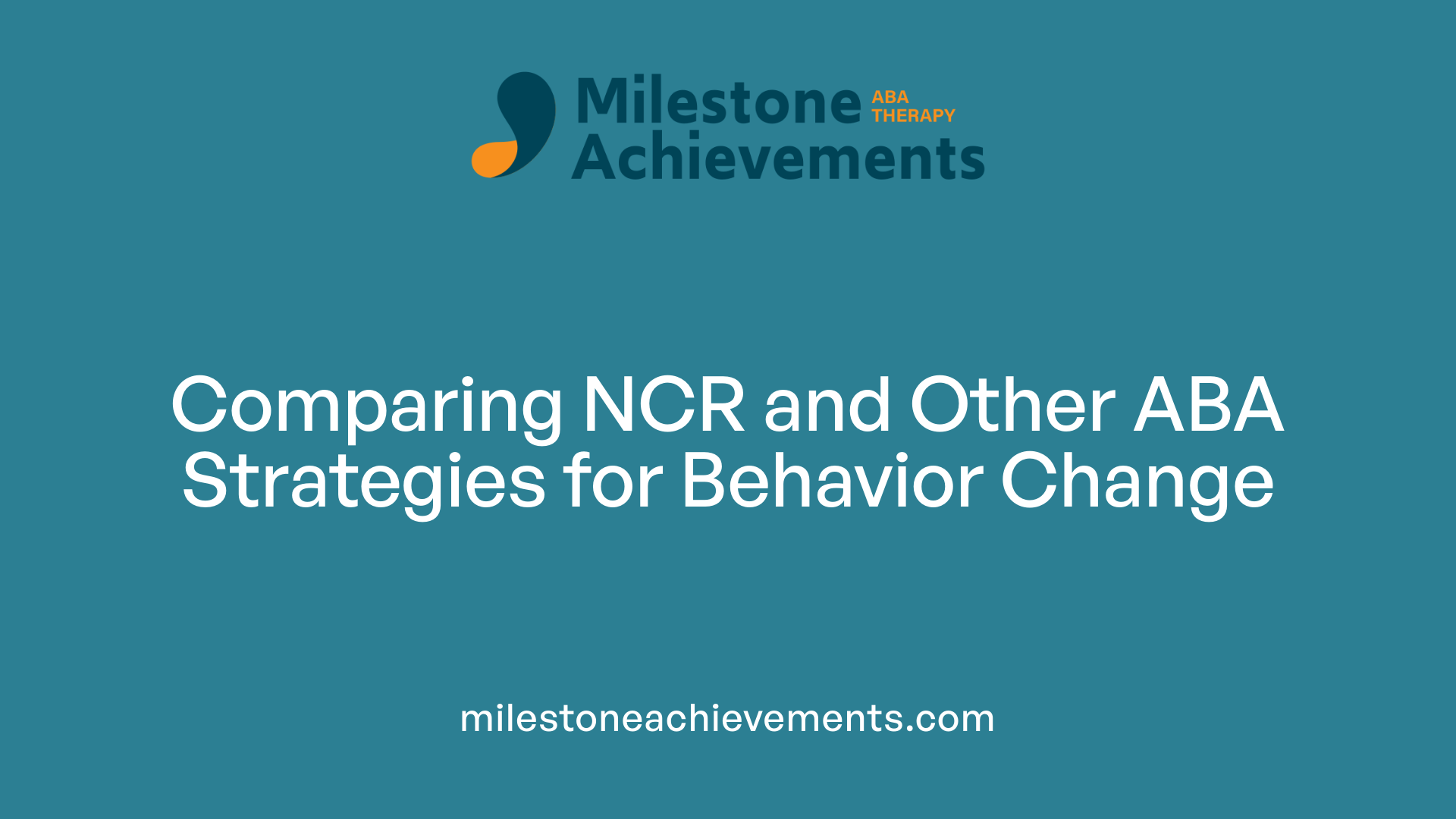
What role does non-contingent reinforcement (NCR) play in reducing problem behaviors?
NCR is highly effective in decreasing undesirable behaviors such as aggression, self-injury, and destructive actions. It does so by providing reinforcement independent of the learner’s specific responses, often on a fixed schedule like every few minutes or after certain periods. This response-independent delivery helps to shift the individual's focus away from problem behaviors that are maintained by escape or attention. For example, giving a child preferred edible items or sensory activities at regular intervals can reduce their motivation to seek such items through disruptive behaviors. NCR is particularly useful because it can lower the occurrence of problem behaviors without requiring extinction procedures, which may sometimes escalate behaviors temporarily.
How does NCR impact skill development and acquisition?
While NCR is primarily implemented to decrease problem behaviors, it also has a role in fostering positive engagement and appropriate behaviors. By establishing a predictable environment where reinforcement is given freely, learners can experience a sense of security and well-being, which may support increased compliance and on-task behavior. However, because NCR provides reinforcement independently of specific skills or behaviors, it might not directly promote skill acquisition unless combined with other targeted teaching strategies such as contingent reinforcement or differential reinforcement. Careful planning is necessary to ensure that NCR does not inadvertently diminish motivation for actively engaging in learning tasks.
How are staff and caregivers trained to implement NCR effectively?
Implementing NCR is relatively straightforward, making it accessible even for staff without extensive behavioral intervention training. Staff need to correctly identify effective reinforcers, establish appropriate schedules, and deliver reinforcement consistently. Step-by-step training typically includes recognizing when and how to administer reinforcement, gradually reducing the schedule as behaviors improve, and ensuring that attention or other reinforcers are not delivered contingently on undesired behaviors. Emphasizing consistency across caregivers and providing clear guidelines help maintain high fidelity in implementation. Regular supervision and data collection are also essential to determine when adjustments are needed to maximize benefits.
How does NCR compare to other reinforcement strategies like contingent reinforcement?
| Strategy | Delivery Method | Focus | Typical Use | Impact | | --- | --- | --- | --- | --- | | NCR | Reinforcer is given on a schedule, regardless of behavior | Reduces problem behavior, improves mood | As a calming or initial intervention | Decreases problematic behaviors, may reduce motivation for attention | | Contingent reinforcement | Reinforcer depends on specific targeted behaviors | Increases desired behaviors | For skill acquisition and shaping | Reinforces specific skills, strengthens behaviors through immediate, behavior-dependent rewards |
In summary, NCR is especially effective for initial behavior reduction and improving the general environment, while contingent reinforcement is geared toward skill learning and specific behavior change. Both strategies are valuable, and their use depends on individual needs and treatment goals.
Resources and Education About NCR in Autism
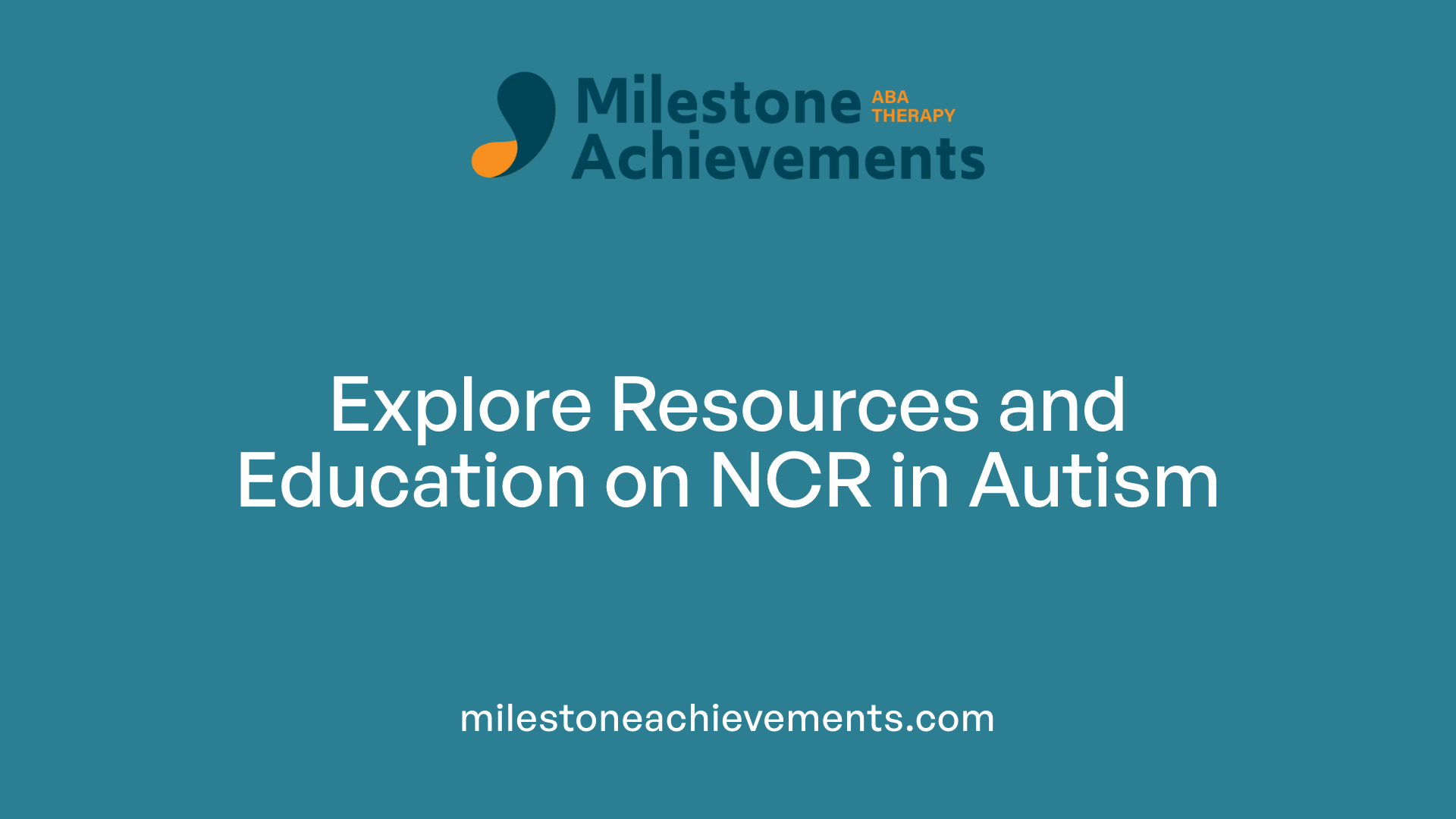 Understanding noncontingent reinforcement (NCR) and its application in autism intervention is essential for practitioners, educators, and families. A variety of resources are available to enhance knowledge and implementation skills.
Understanding noncontingent reinforcement (NCR) and its application in autism intervention is essential for practitioners, educators, and families. A variety of resources are available to enhance knowledge and implementation skills.
Professional organizations such as the Association for Behavior Analysis International (ABAI) and the Autism Society offer comprehensive information about NCR. These organizations provide guidelines, policy updates, and training opportunities tailored to applied behavior analysis (ABA) strategies, including NCR. Membership benefits often include access to conferences, seminars, and publications that delve into the latest research and best practices.
Academic journals are valuable sources for scientific studies and reviews on NCR. Publications like the Journal of Applied Behavior Analysis and Behavior Analysis in Practice regularly feature articles on the effectiveness, methodology, and case studies involving NCR. Reading these articles can help practitioners understand how to tailor NCR schedules to individual needs and to assess its impact on problem behaviors and compliance.
For ongoing education, numerous online training modules and resources are available. Websites such as the Autism Internet Modules (AIM) and the Behavior Analyst Certification Board (BACB) provide accessible tutorials, accreditation courses, and detailed instructions for implementing NCR correctly. These platforms often include videos, quizzes, and scenario-based learning to reinforce understanding.
Books and other professional literature authored by experienced behavior analysts offer in-depth guidance on NCR. Titles like Applied Behavior Analysis by Cooper, Heron, and Heward or Behavioral Interventions in Schools provide foundational knowledge as well as practical strategies for using NCR effectively in various settings.
Finally, many universities with ABA programs publish guides, conduct workshops, and offer certification courses that cover NCR comprehensively. These educational opportunities are valuable for practitioners seeking to deepen their competence.
Summary Table of Resources and Education on NCR in Autism:
| Resource Type | Examples | Purpose | Access Method |
|---|---|---|---|
| Professional Organizations | ABAI, Autism Society | Guidelines, networking, updates | Membership, websites |
| Journals | Journal of Applied Behavior Analysis, Behavior Analysis in Practice | Research, reviews, case studies | Subscriptions, online access |
| Online Modules | Autism Internet Modules (AIM), BACB | Training, tutorials | Online platforms |
| Books | Applied Behavior Analysis by Cooper et al. | In-depth strategies, theory | Purchase, libraries |
| Academic Programs | University ABA courses | Formal education, certification | University enrollment |
These resources collectively provide a solid foundation for understanding and applying NCR effectively to support individuals with autism.
Summary and Future Directions in NCR for Autism
In summary, Non Contingent Reinforcement stands out as an empirically supported, practical, and adaptable strategy for managing and improving behaviors associated with autism. Its response-independent delivery of reinforcement helps reduce problematic behaviors and foster more positive engagement, especially when combined with other behavioral interventions. As research continues to evolve, further refinement of NCR techniques—such as optimal scheduling and reinforcer selection—will enhance its effectiveness. For practitioners, ongoing education and adherence to best practices ensure high fidelity and the best possible outcomes for individuals with autism. The future of NCR lies in its integration within comprehensive, personalized treatment plans that prioritize the well-being and developmental progress of autism spectrum individuals.
References
- Noncontingent Reinforcement in After-School Settings to ...
- What is the Difference Between Contingent & ...
- Some Effects of Noncontingent Positive Reinforcement on ...
- Non-contingent reinforcement - Autism Hub
- Noncontingent Reinforcement (NCI)
- Noncontingent Reinforcement in After-School Settings to ...
- Some Effects of Noncontingent Positive Reinforcement on ...


Partner with us on your child's journey
Milestone Achievements offers evidence-based ABA therapy to help children with autism reach their full potential. Together we’ll set meaningful goals and celebrate progress every step of the way.
Start ABA Services Today





